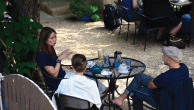The Census Bureau announced today that more than one-in-four same-sex couples counted in the 2010 Census was likely an opposite-sex couple, and identified a confusing questionnaire as a likely culprit. The bureau released a new set of “preferred” same-sex counts, including its first tally ever of same-sex spouses counted in the census.
The official count of same-sex couple households from the 2010 Census: 901,997. The new preferred count: 646,464, meaning that 28.3% of the same-sex couples counted was likely an opposite-sex couple. Of the households in the official count, 552,620 were unmarried couples and 349,377 described themselves as spouses. The new preferred count: 514,735 unmarried couples and 131,729 married couples.
Even this revised same-sex spouse count is likely high, the Census Bureau said, citing estimates that perhaps 80,000 same-sex couples in the U.S. are legally married (although another 85,000 could be in same-sex civil unions). As a previous posting here explained, some same-sex couples in civil unions may believe that calling themselves married is a better description of their relationship than unmarried partner, according to previous census research.
The 2010 Census count was markedly more inflated for same-sex spouses than for unmarried couples, according to data released by the Census Bureau. The 2010 Census count of same-sex unmarried couples was 7% higher than the revised figure. The count of married couples was 62% higher.
Census Warns Data Users
As a result, the Census Bureau told users, the published data for same-sex unmarried partners “is a reasonable portrayal of the size and relative geographic distribution of this population.” But data for same-sex spouses “should be used only with great caution” because “they do not accurately represent” the number of same-sex married couples.
The new preferred numbers are close to estimates from the 2010 American Community Survey, which had a total of 593,324 same-sex households. One of the red flags alerting Census Bureau officials that their Census 2010 same-sex numbers were suspect was that they were so different from those in the ACS, which uses more highly trained interviewers and sophisticated follow-up techniques.
The bureau has identified a culprit in inflating the numbers of same-sex couples: the questionnaire used in door-to-door follow-up at households that did not mail back their 2010 Census forms. The so-called “matrix” form used in the Non-Response Follow-Up operation had a confusing layout that required census-takers to enter data for the same person on two different pages. As a result, bureau analysts said, thousands of people were assigned the wrong gender.
“Errors in the marking of the sex item on 2010 census forms created significant numbers of falsely reported same-sex couples,” said Martin O’Connell, chief of the Census Bureau’s Fertility and Family Statistics Branch.
This questionnaire problem was cited earlier this year by researchers at the Williams Institute at the UCLA School of Law, who estimated that perhaps 25% of same-sex couples counted in the 2010 Census could actually be opposite-sex couples.
Name-Matching Analysis
To double-check its hunch that the form was at fault, bureau analysts employed a statistical directory of names, which is a list of first names scored by how likely they are to be male names, and matched it against responses of households with same-sex couples counted in the 2010 Census to look for inconsistencies. They developed an index for each state—as O’Connell pointed out, “Jean” is likely to be a woman in Wyoming, but there is a good chance “Jean” is a man in Louisiana or states in northern New England with strong French heritages.
O’Connell said the bureau took a conservative approach—for example, not assuming there was an error if a “midrange” name like Kelly was one gender or the other. To create the revised census counts, the bureau removed same-sex couples from the count where analysis strongly suggested they were opposite-sex couples.
Its analysis found that about half the same-sex couples identified on follow-up questionnaires were likely erroneous, compared with 20% of those from mailed-back forms.
One effect of the questionnaire problems is that there seem to be higher error rates in states that required more use of the follow-up forms. The Census Bureau identified a group of states, running from the southern Gulf coast to the upper northwest, as having an unusually high proportion of same-sex couples identified with the follow-up forms. Many of these states have laws defining marriage as between one man and one woman.
Follow-up Data Problems
The faulty form adds to the already well-known problem that data collected in the census follow-up operation tends to be less reliable than information from questionnaires people fill out about themselves and send back. The 2010 Census collects data about living circumstances as of April 1; by the time a census-taker comes to visit, weeks or even months have passed and people may not remember accurately or may have moved from the address in question. In addition, some people who do not mail back census forms may be reluctant to talk with census-takers. In many cases, the census-takers have to collect information from neighbors or landlords.
The problem with counting same-sex couples also illustrates how the impact of a small error is magnified when it is applied to a small population such as same-sex couples (the bureau posted a video on its blog about this topic). The error also would have affected opposite-sex couples, but its impact would be more muted because there are so many more opposite-sex couples.




